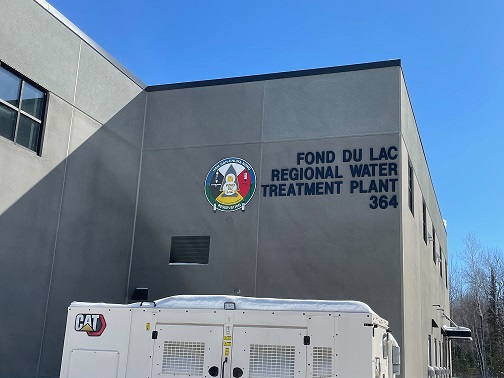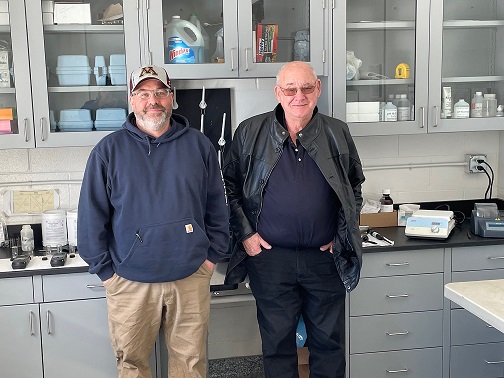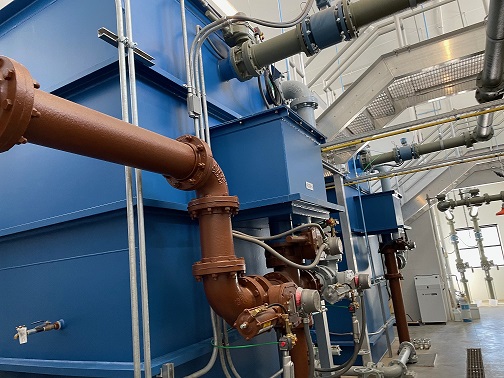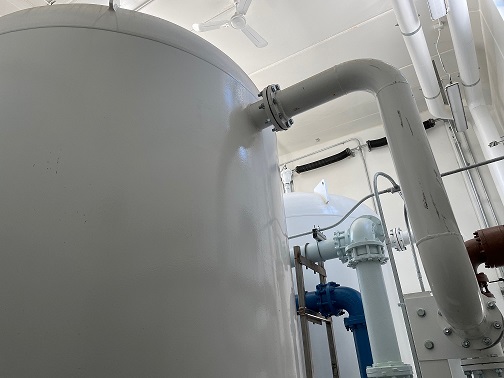Drinking Water Protection
- Drinking Water Protection Home
- About Us
- A-Z Index of Contaminants in Water
- Community Public Water Supply
- Drinking Water Grants and Loans
- Drinking Water Institute
- Drinking Water in Schools and Child Cares
- Drinking Water Revolving Fund
- Laws and Rules
- Noncommunity Public Water Supply
- Source Water Protection
- Water Operator and Certification Training
- Drinking Water Protection Contacts
Related Topics
- Annual Reports
- Drinking Water Risk Communication Toolkit
- Drinking Water Protection External Resources
- Fact Sheets
- Forms
- Invisible Heroes Videos: Minnesota's Drinking Water Providers
- Noncom Notes Newsletter
- Sample Collection Procedures (videos, pictures, written instructions)
- Waterline Newsletter
Related Sites
- 10 States Standards
- Clean Water Fund
- Health Risk Assessment – Guidance Values and Standards for Water
- Minnesota Well Index
- Water and Health
- Wells and Borings
Environmental Health Division
New Treatment Plant Makes Good Water Even Better on Nagaajiwanaang
From the Summer 2024 Waterline
Quarterly Newsletter of the Minnesota Department of Health Public Water Supply Unit, Waterline
A complete list of feature stories can be found on the Waterline webpage.
 Nagaajiwanaang, “Where the Water Stops,” is the name of the homelands of the Fond du Lac Band of Lake Superior Chippewa at the time of the 1854 La Pointe Treaty. The band retained this name in Ojibwemowin for the present-day Fond du Lac Reservation, which was established under the 1854 treaty. The reservation covers nearly 160 square miles, most of it to the west of Cloquet, Minnesota, about 20 miles southwest of Duluth.
Nagaajiwanaang, “Where the Water Stops,” is the name of the homelands of the Fond du Lac Band of Lake Superior Chippewa at the time of the 1854 La Pointe Treaty. The band retained this name in Ojibwemowin for the present-day Fond du Lac Reservation, which was established under the 1854 treaty. The reservation covers nearly 160 square miles, most of it to the west of Cloquet, Minnesota, about 20 miles southwest of Duluth.
One of the last Ojibwe chiefs of the region, Joseph Naganub (Sits Ahead) represented his people in numerous treaty negotiations in Washington, D. C. Sits Ahead, who died in 1894, is buried in Holy Family Cemeteries along the St. Louis River in the northeast part of the reservation. Near him is the grave of a descendent, William “Nitchie” Cadreau, who in 1910 pitched one game in the major leagues, for the Chicago White Sox, under the name of Chief Chouneau.
A baseball diamond near the cemetery dates to the first half of the 20th century when the sport eclipsed lacrosse in popularity among the Ojibwe. However, in 2002 LeRoy DeFoe, the band’s cultural resources specialist, pointed out that the vocation and avocation of log rolling may have been even more popular than baseball. “You gotta understand this river here,” DeFoe said. “At one time it was the White Pine capital of the world. That river used to be full of logs all the way up almost to Brookston [one of the communities within the reservation], which is about 10 miles straight up north from here. That whole area was full of log jams.” DeFoe’s great-grandfather, Joe Medweiosh, is still known to long-time residents for his skill at tearing apart the logs and breaking the jams on the water.
On the topic of water, many of Nagaajiwanaang’s 2,700 bandmembers who reside within the reservation have private wells, some get their water directly from the city of Cloquet, and 126 homes – those in the Mahnomen and Danielson communities – have been supplied by a community water system since 1987.
The system has to comply with all requirements of the federal Safe Drinking Water Act, as do all public water suppliers. However, as a sovereign nation, the Fond du Lac water system is administered by Region 5 of the U. S. Environmental Protection Agency (EPA) rather than the Minnesota Department of Health. Minnesota has 11 federally recognized tribal nations, which often work with Midwest Assistance Program for training and with Bob Klug of Minnesota Rural Water Association for technical assistance for their water systems.
For close to 20 years, the Fond du Lac system operated with a pressure tank and the addition of chlorine. Two softening plants, using ion exchange, were built in the mid-2000s, in each of the communities. “Danielson had good water,” said utilities supervisor Adam Thompson, who grew up on the Fond du Lac reservation. However, because of high levels of total organic carbon (TOC) in the water, the Mahnomen plant struggled with disinfection byproducts. When the system received a violation for total trihalomethanes and haloacetic acids, it began working with SEH, Inc. to explore options and remedies.
John Thom of SEH said the water system worked with the EPA and federal Indian Health Service (IHS) to provide customers with home treatment units as they began a pilot study for the design and construction of a new plant about a mile west of Danielson and a mile-and-a-half southwest of the Mahnomen plant.

Adam Thompson and John Thom
The entire project included two new wells, five-and-a-half miles of water mains, 51 new hydrants, and a 75,000 gallon tower to go with the new 200 gallon per minute (gpm) treatment plant, which uses granular activated carbon (GAC) to reduce the TOC. The new wells are on the east side of the plant, and the water quality is superior in several ways to the previous wells.
The TOC in the raw water in this location is lower, approximately 2.5 parts per million (ppm) as opposed to around 12 ppm in the other wells. Thom pointed out that this level would be fine, if not for the addition of chlorine, which combines with the organic matter to produce the disinfection byproducts. A pair of GAC vessels reduce the organic compounds to allow for pre- and post-chlorination without the resulting byproduct issues.
Iron levels are low, but manganese is on the high side – .21 ppm, approximately four times the secondary standard. To ease the aesthetic issues caused by manganese, the plant has a pair of gravity filters with 12 inches of anthracite on top of 18 inches of GreensandPlus™, a black filter media used for removing soluble iron and manganese. Four inches of silica sand are at the bottom of the filter for nozzle protection.
The filters work with anthracite as the storage and greensand as the barrier. “You fill up that anthracite, and eventually it will push through the greensand,” said Thom, explaining the process. “Greensand is manganese dioxide. When you soak it in permanganate, you get manganese oxide, and that’s what removes the manganese. The soaking is important to build up that layer. Four ounces per cubic foot will give you that coating you’re looking for.”
The incoming water is also treated with gas chlorine. Thom said the pre-chlorine is “to get the oxidation to happen,” adding, “You want to come out the bottom with free chlorine, which means you’ve satisfied the demand for chlorine in that filter.”
After the gravity filters, the water flows into a clearwell and then is picked up by high service pumps and sent through the GAC filters. Ammonia is added as part of the post-chlorination to form chloramines, which aren’t as reactive as free chlorine and less likely to form trihalomethanes.
The total project came to between $14 and $15 million dollars and was financed through federal, state, and band funds. The band was grateful to leverage funds from U. S. Department of Agriculture Rural Development, the U. S. EPA, IHS, a Housing and Urban Development-Indian Community Development Block grant, and the Iron Range Resources and Rehabilitation Board to develop and construct the project.
On top of the other benefits, the raw water has 70 ppm hardness, an unusually low level for groundwater. “A lot of cities would kill for that water,” said Thom. “It’s quite unusual water.” He recalls being questioned by the Indian Health Service about the location of the treatment plant and wells and, in justifying the site, said, “That number. You pay big dollars to get down to 70 parts of hardness.”
The system does not charge its customers for the water, a nice benefit for residents but one that brings challenges. “It reduces their motivations to fix leaks,” said Thompson. The tribe visits homes and searches for leaks, working with the residents to get them fixed. Although most members of the communities served welcomed the new plant, a handful decided to keep their private wells. “We told them the benefits of hooking up to the regional plant, but they stayed on their own well,” said Thompson, noting that they did not force anyone to hook up.
As a community water system, the utility issues consumer confidence reports to its customers and follows other requirements of the Safe Drinking Water Act. Mike Lafave, Fond du Lac’s lead operator, worked with the Indian Health Service on lead service line inventories and has sent them to EPA for review. The system is new enough (its oldest service line was installed in 1986) that it has no lead in the system and has never had an issue with lead and copper sampling.
“This project was successful on a number of fronts,” wrote Fond du Lac public works manager Jordan Vandal, “including buy-in from the Reservation Business Committee, federal and state partners, engineers, and FDL staff who assisted in funding, design, construction and now operation and maintenance of the facility. FDL operations specialists have worked diligently on fine-tuning day-to-day operations to provide high quality, compliant drinking water, and I anticipate them to continue these efforts for Bandmembers which the Regional Drinking Water Treatment Plant serves.”
The new treatment facility opened in the late summer of 2023, and customers are happy with the water, none happier than Thompson, who lives in the Danielson community and said, “I was excited to be hooked up to this.”

The gravity (above) and GAC filters (below)

Go to > top.